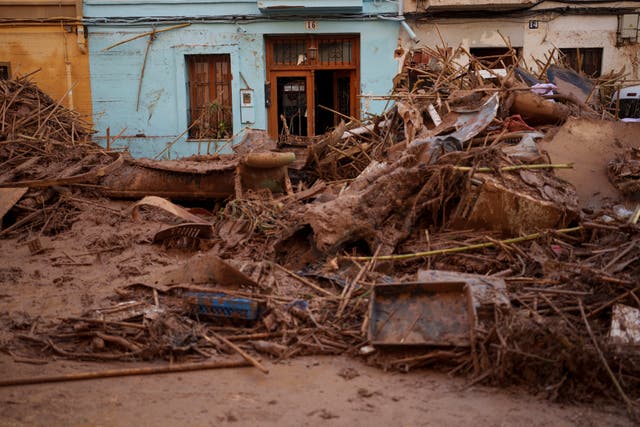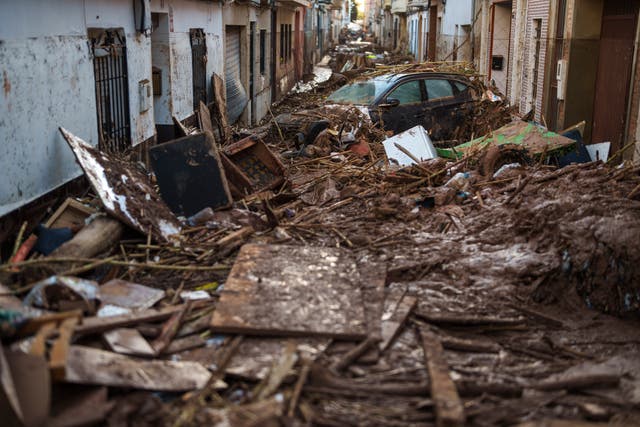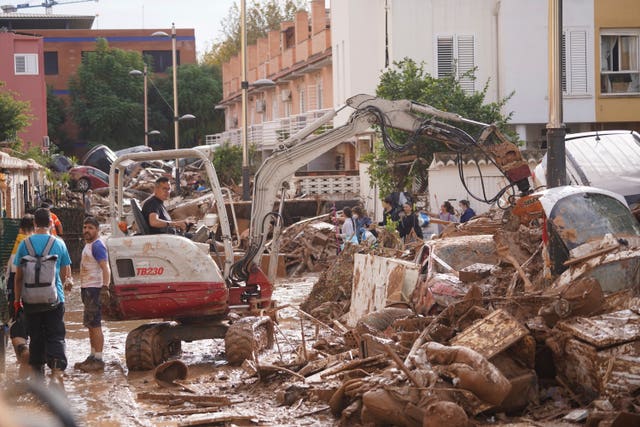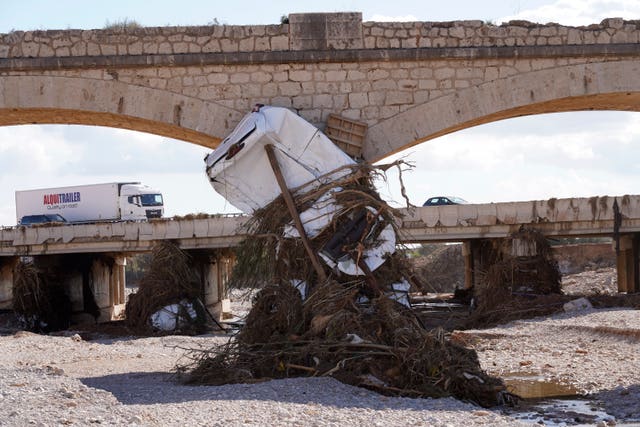
Flash floods caused by heavy rains in eastern Spain swept away everything in their path earlier this week.
With no time to respond, people were trapped in vehicles, homes and businesses. Many died and thousands saw their livelihoods shattered.
Four days later, authorities recovered 205 bodies – 202 of them in the eastern region of Valencia, two in Castilla La Mancha and one in Andalusia.
The search continued on Friday for an unknown number of missing persons.
Thousands of volunteers helped clear the thick layers of mud and debris that still covered homes, streets and roads, as they faced power and water outages and shortages of some basic goods.
Bodies still lay in some vehicles that had been washed into piles or crashed into buildings by the water.
 A house covered in mud is pictured in an area affected by flooding in Valencia (Manu Fernandez/AP/PA)
A house covered in mud is pictured in an area affected by flooding in Valencia (Manu Fernandez/AP/PA)
Here are a few things you need to know about Spain’s deadliest storm in living memory:
The storms concentrated over the Magro and Turia river basins, producing walls of water in the Poyo riverbed that flooded the banks of the river, leaving people unaware as they went about their daily lives, with many returning home on Tuesday evening of their work.
In an instant, the muddy water covered roads and railways and entered homes and businesses in villages on the southern outskirts of the city of Valencia.
Drivers had to take shelter on car roofs, while residents tried to seek refuge on higher ground.
Spain’s national weather service said it rained more in eight hours in the hard-hit town of Chiva than in the previous 20 months, calling the deluge “extraordinary”.
When authorities sent the alert to mobile phones to warn of the severity of the phenomenon and asked people to stay at home, many were already on the road, at work or under water in low-lying areas or garages, which became a death trap.
 A street covered in mud and rubble in Valencia (Manu Fernandez/AP/PA)
A street covered in mud and rubble in Valencia (Manu Fernandez/AP/PA)
– Why did these massive flash floods happen?
Scientists trying to explain what happened see two likely links to human-induced climate change.
One of these is that warmer air holds more rain and then transports it away. The other is possible changes in the jet stream – the river of air over land that moves weather systems around the world – that are producing extreme weather.
Climate scientists and meteorologists say the direct cause of the flooding is a cut-off lower-pressure storm system that migrated from an unusually wavy and stalled jet stream. That system simply parked over the region and dropped rain.
This happens often enough that in Spain they call them Danas, the Spanish abbreviation for the system, according to meteorologists.
Then there is the unusually high temperature of the Mediterranean Sea. By mid-August it had the warmest surface temperature ever recorded, at 28.47 degrees Celsius, says Carola Koenig of the Center for Flood Risk and Resilience at Brunel University of London.
The extreme weather conditions came after Spain suffered prolonged droughts in 2022 and 2023. Experts say drought and flood cycles are increasing due to climate change.
 A small crane clears debris during clean-up operations in Massanassa, just outside Valencia (Alberto Saiz/AP/PA)
A small crane clears debris during clean-up operations in Massanassa, just outside Valencia (Alberto Saiz/AP/PA)
– Has this happened before?
Spain’s Mediterranean coast is used to autumn storms that can cause flooding, but this episode was the most powerful flash flood in recent history.
Elderly people in Paiporta, at the center of the tragedy, claim Tuesday’s floods were three times worse than those of 1957, which killed at least 81 and were the worst in the tourist eastern region’s history.
That episode led to the rerouting of the Turia watercourse, which spared a large part of the city from these floods.
Valencia suffered two other major Danas in the 1980s: one in 1982, which killed about 30 people, and another five years later, which broke rainfall records.
This week’s flash floods are also Spain’s deadliest natural tragedy in living memory, surpassing the flood that swept away a campsite along the Gallego River in Biescas, in the northeast, killing 87 people in August 1996.
 A car stands under a bridge after flooding on the outskirts of Valencia (Alberto Saiz/AP/PA)
A car stands under a bridge after flooding on the outskirts of Valencia (Alberto Saiz/AP/PA)
– What was the state’s response?
The management of the crisis, classified by the Valencian government as level two on a scale of three, is in the hands of the regional authorities, who can ask the central government for help in mobilizing resources.
At the request of Valencia President Carlos Mazon, of the conservative People’s Party, Socialist Prime Minister Pedro Sanchez announced on Saturday the deployment of 5,000 additional soldiers who will join the rescue efforts, clear the rubble and provide water and food throughout the weekend will provide.
The government will also send another 5,000 national police officers to the region, Sanchez said.
Currently, around 2,000 soldiers from the Military Emergency Unit, the army’s first intervention force for natural disasters and humanitarian crises, are involved in the emergency response, as well as almost 2,500 gendarmes of the Civil Guard – who carried out 4,500 rescues during the floods – and 1,800 national police officers .
When many of those affected said they felt abandoned by the authorities, a wave of volunteers took to the streets to help.
With brooms, shovels, water and basic food, hundreds of people have walked miles every day to deliver supplies and help clean up the hardest-hit areas.
Sanchez’s government is expected to approve a disaster declaration on Tuesday that would allow quick access to financial aid. Mr Mazon has announced additional economic support.
Valencia’s regional government was criticized for not sending flood warnings to mobile phones until 8pm on Tuesday, when flooding had already started in some places and long after the national weather agency issued a red alert indicating heavy rain.